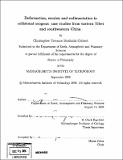| dc.contributor.advisor | B. Clark Burchfiel. | en_US |
| dc.contributor.author | Studnicki-Gizbert, Christopher Terrance | en_US |
| dc.contributor.other | Massachusetts Institute of Technology. Dept. of Earth, Atmospheric, and Planetary Sciences. | en_US |
| dc.coverage.spatial | a-cc-ti a-cc--- | en_US |
| dc.date.accessioned | 2007-08-03T18:19:48Z | |
| dc.date.available | 2007-08-03T18:19:48Z | |
| dc.date.copyright | 2006 | en_US |
| dc.date.issued | 2006 | en_US |
| dc.identifier.uri | http://hdl.handle.net/1721.1/38250 | |
| dc.description | Thesis (Ph. D.)--Massachusetts Institute of Technology, Dept. of Earth, Atmospheric, and Planetary Sciences, 2006. | en_US |
| dc.description | Includes bibliographical references. | en_US |
| dc.description.abstract | This dissertation addresses aspects of the tectonics of regions adjacent to the eastern Himalayan syntaxis. The first chapter describes the Tertiary Gonjo basin, includes structural and sedimentologic observations, and interprets these as a record of limited upper crustal shortening during and immediately after early Tertiary (- 40 Ma) time. The record of Cenozoic shortening of the upper crust cannot account for the gradient of crustal thicknesses from eastern Tibet southeast into Yunnan province. The second chapter provides a review of the regional geology of western Yunnan and the detailed structural geology of the region around the first bend of the Jinsha (Yangzi) river. Structures record a long history of multiple deformation generations, including early Mesozoic metamorphism and cooling, west-directed transport along thrusts and nappes in late Mesozoic time, limited Tertiary shortening and transtensional deformation from Pliocene to present time. The third chapter provides a synoptic view of the active tectonics around the eastern Himalayan syntaxis and integrates geologic mapping, slip-rate estimates, remote sensing, seismicity and geodesy. Fault slip rates are inferred by modeling the elastic deformation near major faults and the motions of a small number of crustal blocks. | en_US |
| dc.description.abstract | (cont.) Elastic block modeling explains geodetic velocities but fails to capture many important aspects of the geologic record, especially poorly localized strain within and near the margins of the Lanping-Simao belt. The final chapter describes the Pliocene to present structural and geomorphic evolution of the Yulong mountains and the interactions of active upper-crustal transtensional deformation, weak lower or middle crust, and geomorphic processes (specifically river incision). The exposure of deep structural levels and high rock uplift rates of the Yulong mountains are explained as the result of erosion processes that balance rock uplift rates, a closed network of normal faults that accommodate differential rock uplift rates, and weak middle crust that flows in response to topographically imposed pressure gradients. | en_US |
| dc.description.statementofresponsibility | by Christopher Terrance Studnicki-Gizbert. | en_US |
| dc.format.extent | 296 p. | en_US |
| dc.language.iso | eng | en_US |
| dc.publisher | Massachusetts Institute of Technology | en_US |
| dc.rights | M.I.T. theses are protected by copyright. They may be viewed from this source for any purpose, but reproduction or distribution in any format is prohibited without written permission. See provided URL for inquiries about permission. | en_US |
| dc.rights.uri | http://dspace.mit.edu/handle/1721.1/7582 | |
| dc.subject | Earth, Atmospheric, and Planetary Sciences. | en_US |
| dc.title | Deformation, erosion and sedimentation in collisional orogens : case studies from eastern Tibet and southwestern China | en_US |
| dc.type | Thesis | en_US |
| dc.description.degree | Ph.D. | en_US |
| dc.contributor.department | Massachusetts Institute of Technology. Department of Earth, Atmospheric, and Planetary Sciences | |
| dc.identifier.oclc | 150505040 | en_US |
